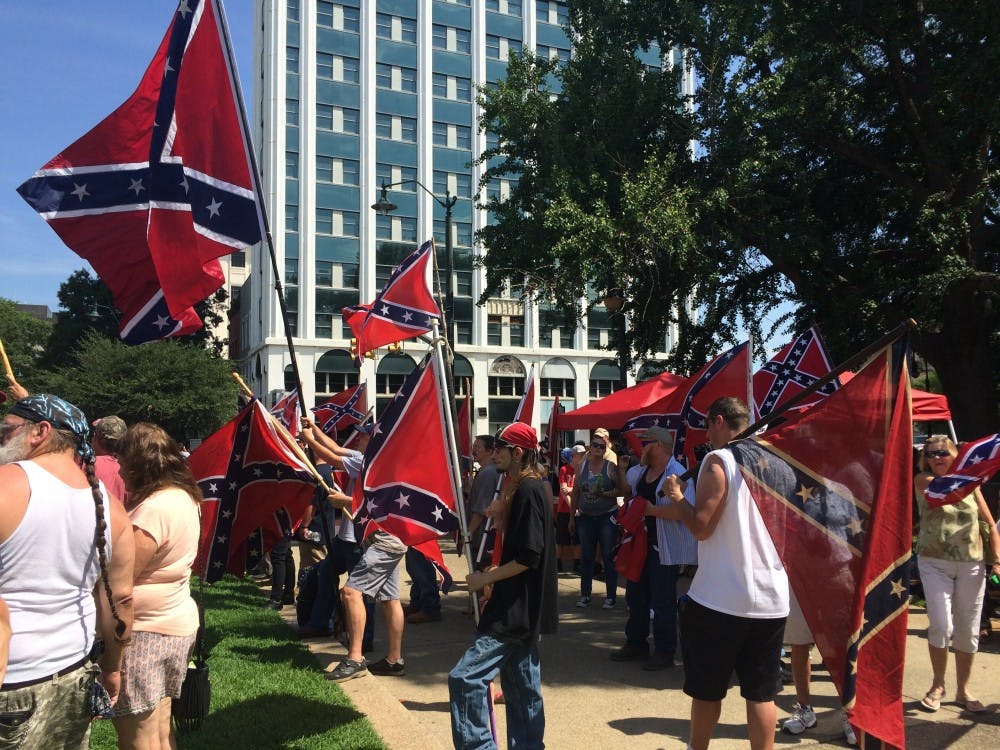With most USC students away, what could have been a rather quiet summer in Columbia instead was instead one filled with outspoken citizens calling for change.
The same could be said of the summer of 2015, in which South Carolina Gov. Nikki Haley successfully pushed for a two-thirds House vote to remove the Confederate battle flag from Statehouse grounds. On July 10, 2015, people gathered on the government property to protest the flag's removal, putting the city in a national news spotlight.
Concerns surrounding the Confederate flag arose following the deadly shooting of nine African-American parishioners at Mother Emanuel AME Church in Charleston. The alleged shooter, a white supremacist, sported the flag among white supremacist symbols.
In the eyes of many, the flag represents a racist past and is still a symbol of racism rather than pride in a Southern heritage.
"After the tragic, hate-filled shooting in Charleston, it is only appropriate that we deal once and for all with the issue of the flag," said Sen. Lindsey Graham upon Haley's call to remove the flag.
The flag removal and protests thereafter were not the only results of the Charleston shooting. The murder of nine black South Carolinians fueled the Black Lives Matter movement, another cause for which many people choose to rally. The Confederate flag came down after Black Lives Matter protesters called for it by gathering outside the Statehouse, chanting, "Take it down!"
Fast-forward to the summer of 2016, and the rebel flag is still gone from the Statehouse lawn. The South Carolina Secessionist Party, along with other advocates and supporters of the flag, organized a rally to call for the flag's return.
The rally was not simply to protest the flag's absence, but also to honor Confederate soldiers who fought and died for South Carolina and other Southern states. For both reasons, the Stars and Bars flooded the government property on July 10, exactly one year after they were taken away.
People attending the rally flew their own flags and wore hats and T-shirts with the flag's design on them. Among those people were citizens in Civil War re-enactment costumes. People carried flags with phrases on them, such as "These colors don't run," "I ain't coming down" and "Heritage not hate."
The Secessionist Party ceremoniously raised their own Confederate flag on a 30-foot pole in the same spot on the lawn that the original flag once flew.
"Our flag is missing. We came to put it back," said party chairman James Bessenger before the flag was raised. "So, without any more delay, let's put it back." People applauded, and as the flag went up, they chanted, "Leave it there! Leave it there!"
Live music, guest speakers and a common desire to see the flag rise again united a rally with hundreds of red-and-blue-clad citizens.
Tragedy struck in the week leading up to the rally, though, just as it had in 2015. The fatal shootings of Alton Sterling in Baton Rouge, Louisiana, and Philando Castile near Minneapolis, Minnesota, by local police officers sparked sparked outrage and Black Lives Matter protests across the U.S. Another tragedy occurred in Dallas, Texas, with the murder of five police officers. The Columbia Confederate flag rally had already been organized before these events happened, as had a Black Lives Matter counterprotest. The counterprotest was canceled while the flag rally stayed on schedule, and many of those in attendance wore black ribbons on their wrists in remembrance of the fallen Dallas officers.
Though the originally organized counterprotest was indefinitely postponed, it did not stop Black Lives Matter protesters from showing up on Gervais Street during the Confederate flag rally to make their voices heard.
"Your flag represents hate — hate!" protesters chanted, led by a man with a bullhorn. There was a gate barricading the Statehouse lawn off from the Gervais Street side, and people advocating for each cause were restricted to their respective sides of the gate. Flag toters chose to ignore the protesters, who remained persistent.
Several hours after the rally, citizens gathered outside the Statehouse again for a Black Lives Matter protest. The late morning and early afternoon were electric with the flag rally and the first protest storming the Statehouse grounds, but this evening protest, while much larger, had a calmer, more serious tone. Protesting against what is thought to be a system of continued injustice toward the black community, citizens marched from Statehouse through different parts of Columbia.
Eight hundred people marched on that evening, The State Newspaper reported. The protesters blocked Interstate 126 shortly before continuing and eventually bringing themselves back to the steps of the Statehouse.
As many police officers stood at the top of the steps, protesters sat with each other, chanting, "No justice, no peace," and voicing their infuriation and exhaustion from black citizens being killed by police officers. The protests were carried out peacefully into the late night with no incident reports.
The organizer of the march, Patrick Tate, followed up afterward by calling on fellow Black Lives Matter movement supporters and bringing them to meet with Columbia police to discuss police-to-citizen relations. Tate and members of the Columbia Police Department discussed ways to carry rallies and protests out peacefully, and Tate also emphasized doing away with the idea of a war between African-Americans and police. Chief Skip Holbrook said he believes the discussion has raised the degree of trust.
Columbia is home to students, organizers, lawmakers, protesters, flag wavers and officers. An eventful summer proved its residents' ability to advocate for causes, even those that may conflict, both passionately and peacefully.

